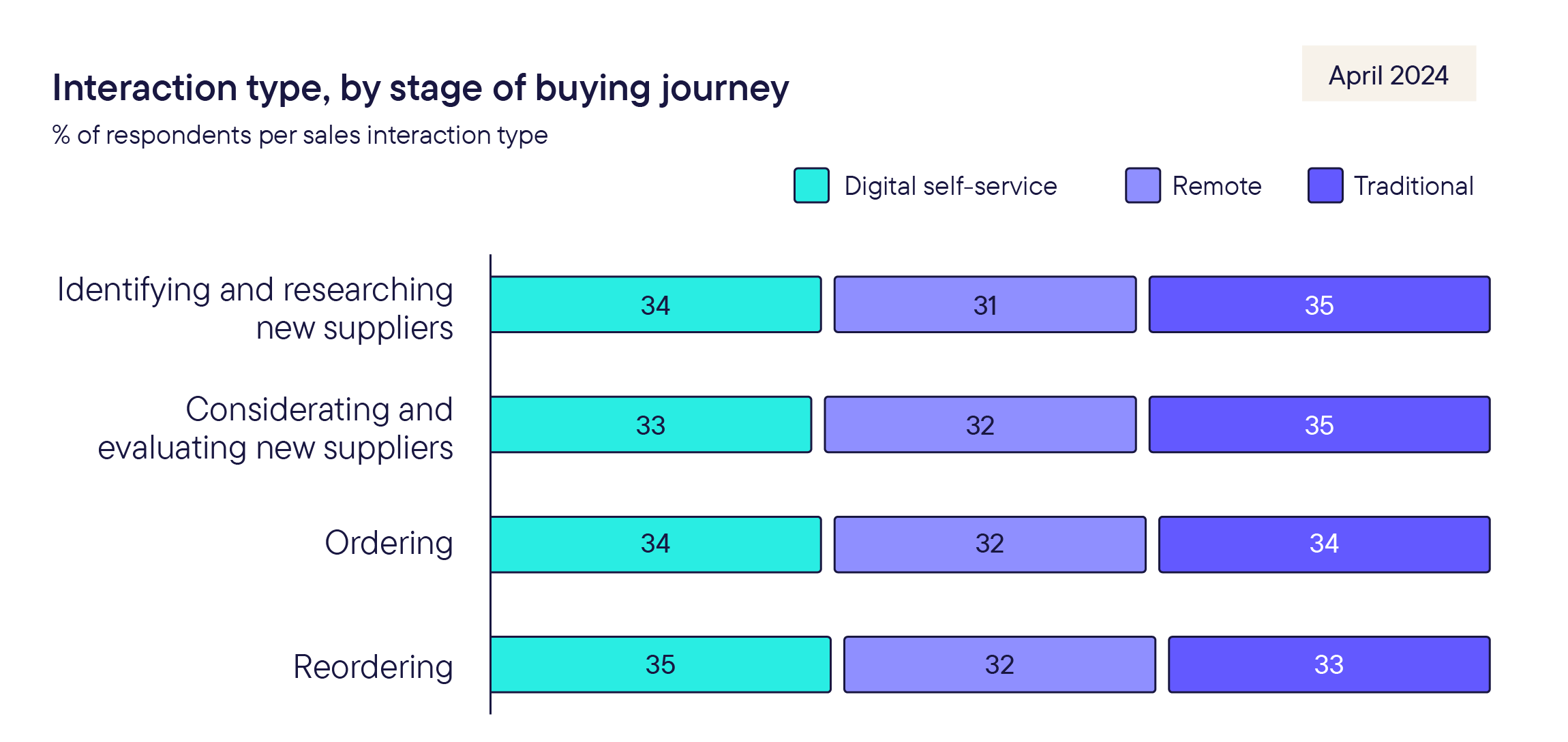
Is the growth of B2B commerce driven by digital- or human-based interactions? If you said both, you’re absolutely right! While practitioners are purchasing online more than ever, they want to engage with the sales representatives of their suppliers on their own terms to better understand product fit and negotiate prices. The future of B2B sales is here — and it’s hybrid.

What’s a hybrid sales approach in B2B commerce?
Hybrid sales combine digital channels (such as eCommerce platforms, self-service portals and even AI-driven chatbots) with human interactions (such as sales representatives, account managers and customer support). This approach enables B2B companies to cater to a broader range of customer preferences, allowing buyers to move seamlessly between self-service and personalized support, helping organizations meet their buyers where they are.
While digital commerce in B2B has grown tremendously in recent years — propelled initially by the lockdowns of the COVID-19 pandemic, which accelerated buyer behavior’s shift toward digital — the fact remains that one-on-one relationships continue to be mission-critical for many B2B buyers.
This is because not every B2B transaction is equal. Yes, eCommerce sites are increasingly able to handle easy product reorders and subscriptions, but the reality for many manufacturers, wholesalers and distributors is that certain products are custom, pricing and entitlements tend to be customer-specific, and purchases costing millions of dollars aren’t going to be completed only using a customer portal.
That said, B2B businesses must be prepared to provide a hybrid sales approach that offers a seamless combination of digital and human touchpoints — powered by a unified commerce platform.
How is hybrid sales evolving in B2B?
As B2B commerce evolves, it’s clear that buyers want the best of both worlds: A mix of digital technology and personal relationships to help them find what they’re looking for, exactly where and when they’re looking for it, get customized pricing and terms and order items seamlessly. In fact, 64% of B2B buyers still prefer in-person interactions¹, proving that digital commerce isn’t an all-or-nothing proposition.
According to Master B2B², while 41% of buyers prefer to do their own research online instead of interacting with a salesperson during this process, 46% prefer to speak to a salesperson on the telephone as their primary source of research. So, it comes as no surprise that sellers will seamlessly integrate into B2C and B2B digital commerce interactions, stepping in when customers require direct involvement by 2030³.
Furthermore, the “rule of thirds” has remained stable since 2019⁴, with a healthy mix of in-person interactions, remote communications and digital self-service — each channel taking about one-third of buyer interactions at any given stage of the B2B buying journey.
Companies that have increased their hybrid sales teams by more than 10% are 79% more likely to be market share winners compared to those with less emphasis on hybrid models. This indicates a direct correlation between hybrid sales strategies and competitive advantage.

What’s more, online and offline interactions complement and influence each other’s success. A recent survey² revealed that 32% of sellers say that more than half of their sales are influenced by the online channel, and 64% of buyers say that they research the majority of their purchases online before buying offline.
In other words, as hybrid selling expands with technological advancements that blend digital and traditional sales, we expect sellers will become more comfortable with digital tools and use them to boost their own performance — as well as the company’s. Meanwhile, B2B organizations need to address thorny themes, such as change management and sales commissions coming from eCommerce, to unleash the full potential of hybrid sales in the years to come.
The hybrid sales approach is growing in 3 ways in B2B commerce
How does a hybrid approach impact sales representatives?
Every story has two sides: Winners and losers. And, for a long time, many B2B professionals assumed that sales representatives would end up on the losing side⁵ of the eCommerce revolution. Fortunately, this assumption couldn’t be further from the truth. As already noted, buyers continue to rely on sales representatives when it’s most convenient for them, such as navigating complex purchases.
That said, the role of B2B sales representatives is undeniably evolving, shifting their focus from transactional interactions to strategic relationship-building. Here’s how:
From order-takers to trusted advisors: With self-service options handling routine transactions, sales reps are now expected to provide deeper insights, consultative selling and tailored recommendations.
Leveraging data and cutting-edge tools for smarter selling: Sales teams can utilize real-time analytics from unified commerce platforms to understand customer behavior, anticipate needs and proactively engage buyers at critical touchpoints. Giving your sales teams the right tools powered by data will make all the difference.
Enhancing efficiency with automation: AI-powered tools and automation reduce administrative burdens, allowing sales representatives to focus on higher-value activities such as personalized outreach and relationship management.
Blending digital and human interactions: Sales reps now engage buyers through multiple digital channels (video calls, live chat, emails) while still providing in-person support when necessary, ensuring a seamless hybrid experience.
Expanding customer engagement beyond transactions: Instead of solely closing deals, sales professionals now play a key role in guiding customers throughout their journey, from initial research to post-purchase support. This ensures long-term satisfaction and loyalty, as well as shorter sales cycles.
How a distribution company created a hybrid sales strategy for sustained success
A leading distribution company focused on serving small businesses in Chile thrived for a long time with an in-person sales approach. Sales representatives play a crucial role in the business, managing orders through direct visits to points of sale across the vast South American country, but this model was severely disrupted during the COVID-19 pandemic.
To streamline the ordering process with sales reps — who still bring the bulk of revenue for the company — and meet the needs of increasingly younger buyers, the distributor embarked on enabling a robust hybrid sales model that empowers sales reps, customers and even fulfillment vendors.
Thanks to commercetools’ unified commerce platform, the company developed and seamlessly connected four core channels: A primary eCommerce site, an in-person sales app, a customer app and an app for carriers managing fulfillment. This digital transformation marked a shift from a fully in-person sales approach to a comprehensive omnichannel model, enabling the company to grow in a competitive market.
How can sales reps be motivated to embrace digital for B2B hybrid sales success?
One of the biggest challenges for B2B businesses adopting digital channels is how to get sales representatives — and commercial teams in general — on board. Explore the best practices that we have seen first-hand with our customers:
Ensure sales reps earn commissions for online purchases made by their assigned clients. You can also implement attribution models that track and credit sales reps for their contributions, such as initial prospecting, relationship management or advisory roles.
What’s more, consider rewarding sales teams for increasing online adoption among their clients, and even tiered bonuses based on the percentage of client orders that transition to online orders. Encouraging proactive outreach when analytics show a client struggling with the online system is also a great way to increase engagement and conversion.
The rule of thumb is to encourage reps to guide customers toward the online platform for efficiency while still maintaining a personal touch for complex needs. As the role of sales teams undoubtedly changes in this hybrid scenario, it’s crucial that your reps feel supported and trained to act as consultants rather than just order-takers.
You can also train sales teams on using digital selling to their advantage. Equip reps with skills to drive digital engagement, including social selling (if that’s applicable to your business) and virtual demos.
Do you know what will make your sales teams’ job even easier? Data. By providing your sales reps with insights from online interactions (e.g., what products customers are browsing but not purchasing), you can enable them to follow up strategically and offer personalized recommendations. This approach is also a great door opener for upselling and cross-selling.
Once you have a single view of commerce data and operations — a benefit of relying on a unified commerce platform — you can ensure clients receive consistent service, pricing, discounts and more whether they interact with a rep or self-service online.
What’s the difference between omnichannel commerce and hybrid sales?
While omnichannel commerce and hybrid sales are closely related, they serve different purposes in B2B commerce:
Omnichannel commerce refers to providing a seamless and consistent buying experience across multiple channels — online stores, mobile apps, marketplaces and in-person sales. The goal is to ensure that customers can engage with a brand in a seamless way, no matter where they interact.
Hybrid sales, on the other hand, is a specific sales strategy that blends self-service digital tools with human-led engagement. It allows businesses to balance automated, low-touch sales processes with high-touch, consultative selling.
While omnichannel commerce ensures consistency across platforms, hybrid sales focuses on how sales teams and technology work together to optimize customer interactions. A successful hybrid sales strategy relies on omnichannel capabilities to provide customers with flexibility in how they engage and purchase.
How does unified commerce support hybrid selling, and how does commercetools enable it?
Unified commerce is different from and goes beyond omnichannel by integrating all sales channels into a single, cohesive system. It plays a crucial role in making hybrid sales successful by eliminating data silos and ensuring seamless interactions across digital and human-led channels in five ways:
A single source of truth for customer data: Unified commerce consolidates customer interactions, purchase history and preferences into one system, enabling personalized and context-aware engagement across sales channels.
Real-time synchronization for frictionless transactions: Whether a customer starts their journey online and completes it with a sales rep or vice versa, unified commerce ensures that all interactions are updated in real-time, preventing miscommunication or redundant efforts.
Enhanced agility with composable architecture: With a composable approach, businesses can easily integrate best-of-breed tools to support both digital self-service and human-led sales, adapting their strategy as buyer expectations evolve.
Seamless omnichannel and hybrid sales integration: By bridging the gap between digital commerce, CRM systems and in-person sales tools, unified commerce enables smooth transitions between different touchpoints, improving customer experience and conversion rates.
Empowering sales teams with data-driven insights: Sales reps can access real-time insights on customer behavior, product interests and past interactions, allowing them to provide proactive and highly relevant support.
With centralized data and processes, businesses can deliver real-time order tracking, inventory visibility and personalized recommendations — whether buyers interact online or offline. For example:
A buyer sees the same contract-based pricing and available inventory through an online portal as they would in direct conversations with a sales rep.
A buyer might browse products online, get a quote from a sales representative and then finalize the order through a customer portal.
A buyer might research product specifications online, schedule a visit to the manufacturer’s showroom or demonstration center to see the equipment in action, and later use a digital portal to review customization options, view related spare parts, finalize their purchase or arrange for delivery to multiple locations.
A unified commerce platform makes all this possible by providing real-time access to critical data, enabling businesses to offer accurate inventory details, personalized pricing and consistent customer support across every touchpoint. The result? Faster purchasing cycles and a smoother buyer experience — key advantages in a sector characterized by lengthy buying processes and high-stakes transactions.
In other words, commercetools, as the most versatile commerce platform globally, provides enterprises with the flexibility, scalability and unified approach needed to power hybrid selling. For the first time, B2B companies can create customer-centric sales experiences that drive growth, efficiency and long-term success, making the most of both human and digital ways of doing business.
Sources: ¹SBI ²Master B2B ³Gartner ⁴McKinsey ⁵Forbes
